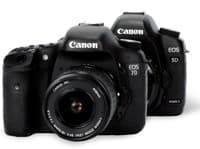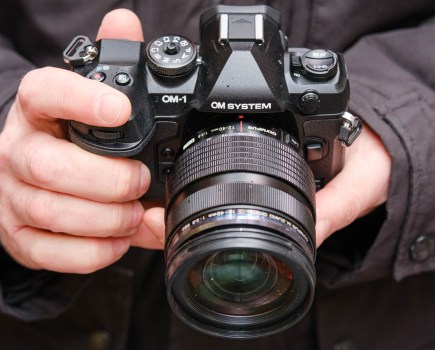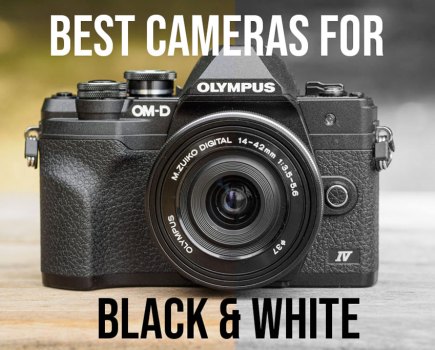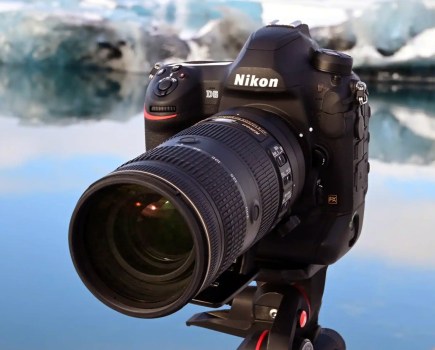 Progress made with in-camera noise suppression and high-sensitivity performance means that APS-C-format cameras now produce larger, better-quality images than ever before. Angela Nicholson looks at the Canon EOS 7D and EOS 5D Mark II to see whether full frame still holds an advantage.
Progress made with in-camera noise suppression and high-sensitivity performance means that APS-C-format cameras now produce larger, better-quality images than ever before. Angela Nicholson looks at the Canon EOS 7D and EOS 5D Mark II to see whether full frame still holds an advantage.
Everyone likes to hear a David and Goliath-type story where two seemingly unevenly matched opponents clash and the minnow comes out victorious.
For photographers, the possibility that a small-format camera can produce similar (or even better) quality images to a model with a larger sensor is enticing on several levels, not least because the smaller sensor size usually makes the camera more affordable.
As such, there was quite a bit of excitement when our test of the APS-C-format Canon EOS 7D revealed that it produces images that give the full-frame EOS 5D Mark II a run for its money.
In this test I’m going to see if the new generation of APS-C cameras really can produce the type of quality we have come to expect from full-frame models. The EOS 5D Mark II and EOS 7D will be the main focus, but I’ll also compare the results from the Nikon D3S and D300S, and the Sony Alpha 850 and Alpha 550, and look at the pros and cons of full-frame and APS-C-format photography.
How we match composition to compare cameras

There are essentially two ways of matching the framing of images when shooting with APS-C-format and full-frame cameras. The first is to have greater distance between the subject and the APS-C-format camera than with the full-frame model. The second is to adjust the focal length so that the effective angle of view is the same on both cameras. I used both of these approaches during this test to produce comparable images.
Canon EOS 5D Mark II
Canon’s EOS 5D was the first camera to make full-frame digital photography possible for many enthusiast photographers. It allowed them to use the lenses they had been using on their Canon 35mm film cameras and see exactly the same composition in the viewfinder. The larger sensor also allowed room for bigger photoreceptors so, in addition to having a greater pixel count, the camera could produce images with less noise than its APS-C-format counterparts.
It’s worth remembering at this point that sometimes it isn’t the amount of visible noise that is a problem for image quality, but the level of noise reduction that is applied to the files. Canon has in the past been guilty of being a little too liberal with its noise-reduction algorithms, and some of the EOS 5D’s APS-C-format contemporaries were prone to producing rather soft JPEG files as a result.
As it sat just on the right side of affordability (in comparison to Canon’s EOS-1D-series DSLRs), the EOS 5D was a big seller and was popular with professional and enthusiast photographers alike. However, after around three years it was starting to look a little dated and in September 2008 its replacement, the EOS 5D Mark II, was unveiled.
With the possible exception of its HD video capability, this camera’s specification was fairly predictable, and the upgrade was primarily about bringing the camera into line with Canon’s other DSLR offerings with the inclusion of Live View technology, a sensor cleaning system, 14-bit processing, Highlight Tone Priority and Auto Lighting Optimiser. The increase in pixel count to 21.1 million effective pixels and the Digic 4 processor could also have been anticipated.
One significant change from the original EOS 5D, however, was the ability to expand the native sensitivity range from ISO 100-6400, to include settings equivalent to ISO 50, 12,800 and 25,600. This highest setting, which is now trumped by the ISO 102,800 of the Nikon D3S and Canon EOS-1D Mark IV, matched what was possible with high-end Nikon DSLRs at the time.
Canon EOS 7D
While the EOS 5D Mark II’s arrival had been anticipated for many months, the EOS 7D came as a surprise to many. It isn’t an upgrade or a replacement for an earlier model, but it usurped the EOS 50D’s position at the top of Canon’s APS-C-format line-up and is the first of a new series of Canon cameras with a single-digit name.
The camera’s specification also revealed a few surprises, suggesting that Canon has started to rethink some of its previous policies and was wanting to tackle the challenge raised by Nikon and, to a lesser extent, Sony. For instance, after saying for several years that it was unnecessary because of the existence of the Speedlite Transmitter ST-E2, the manufacturer finally conceded that in-camera wireless flash control is desirable.
The EOS 7D also debuted a 19-point AF system that borrows features from the EOS-1D Mark III to allow the photographer to customise its response to suit the subject, and the new Focus Colour Luminance (iFCL) metering system, which uses subject distance, colour and luminance information. In comparison, the EOS 5D Mark II has the same metering and AF systems as its predecessor with Canon’s well-established 35-zone evaluative metering system (backed up by centreweighted, partial and spot metering), and nine selectable AF points supported by six non-user-selectable auxiliary points.
While Nikon is firmly sticking to its guns that 12 million pixels is enough on an APS-C-sized sensor (and, with the exception of the D3X, on a full-frame device), Canon is a bit more ambitious in this respect. When the EOS 7D was announced, the prospect of images with 18 million pixels being produced by a camera with a 22.3×14.9mm (APS-C sized) CMOS sensor was both alarming and exciting at the same time. Although the images might be large, there was also the possibility that they could be very noisy – like the results from the EOS 50D – or suffer from the effects of heavy-handed noise reduction.
However, Canon employed a new sensor with less circuitry for the EOS 7D, which allows its photodiodes to be larger, helping high-sensitivity and dynamic range performance.
Canon also employed a new design for the diodes to allow them to convert more light into an electrical charge for a higher signal-to-noise ratio. The diode’s capacity has also been increased to reduce overloading in bright light and extend the dynamic range. As in the EOS 5D Mark II, the gapless micro lenses over the photodiodes sit closer to the photoreceptors, enabling more light
to reach the sensitive surface.
All these factors combine to allow the EOS 7D to produce significantly larger, cleaner and more detail-rich images than we have seen before from a Canon APS-C-format DSLR.
Image sizes of the 5D vs the 7D
At 300ppi, prints of images from the Canon EOS 5D Mark II measure 47.55×31.7cm, while those from the EOS 7D measure 43.89×29.26cm. This means both cameras are capable of producing images that make good A3 (29.7x42cm) prints.
When A2 (42×59.4cm) prints are required, the resolution of the EOS 5D Mark II’s images must be dropped to 240ppi, while those from the EOS 7D must be printed at around 223ppi.
At lower sensitivities it is impossible to distinguish between images from the two cameras when they are enlarged in this way. At higher sensitivity settings, however, the EOS 7D’s images are more granular and chroma nose is visible. The amount of noise isn’t objectionable, but the EOS 5D Mark II images are smoother.
Canon 5D vs 7D – Optics and focal length

Image: These two sequences were taken from exactly the same spot to demonstrate the impact of the 1.6x focal length multiplication factor across the 16-35mm focal length range
As an APS-C-format sensor is smaller than a full-frame device, it effectively crops the image when a full-frame lens is mounted. The result is similar to using a longer focal length optic than the one actually mounted on the camera, so the effect is often referred to as focal length magnification. With Canon’s APS-C-format DSLRs such as the EOS 7D, the focal length magnification factor is 1.6x, but with Nikon and Sony models such as the D300S and Alpha 550 it is 1.5x.
For enthusiast photographers who started out with 35mm film cameras, the focal length magnification of APS-C-format DSLRs can be a source of some frustration, as a much-loved 24mm optic on an EOS 7D produces the framing that we would expect to see at around 38mm. However, at least APS-C-format cameras use the central area of 35mm-format lenses, and this can benefit image quality.
In recent years manufacturers have addressed the magnification issue by producing much wider optics specifically designed to work with the smaller-format cameras. Canon’s shortest focal length, for example, appears in a zoom lens for the APS-C format: the EF-S 10-22mm f/3.5-4.5. This has an RRP of £990 and it produces images similar to a 16-35mm lens on 35mm format.
A list price of just under £1,000 is not to be sniffed at, but full-frame users who want the same framing will find they have to shell out considerably more for the EF 16-35mm f/2.8L USM, which is listed at £1,400, or the EF 16-35mm f/2.8L II USM at £1,790. Although these two lenses benefit from Canon’s superior L-series build quality and a wider (constant) maximum aperture, full-frame users may prefer to opt for the EF 17-40mm f/4L USM, which has a more manageable RRP of £940.
At the other end of the focal-length spectrum, the APS-C format’s magnification factor allows photographers to frame distant subjects more tightly than full-frame photographers can with the same optic. This means that on the EOS 7D, the £960 EF 200mm f/2.8L II USM offers framing not too far off what is seen with the EF 300mm f/2.8L IS USM, which has a list price of £5,630. The shorter length lens isn’t stabilised, but at 765g it’s less than a third of the weight of the 2.55kg 300mm optic, and as it’s almost half as long it is easier to hold still anyway. It also takes up a lot less space in your bag and is easier to carry, so you are far more likely to take it out in the first place.
The focal length magnification factor is also useful with close-up and macro photography, as subjects appear larger in the frame at the same focusing distance. As such, a lens that achieves 1:1 magnification effectively produces images with 1.6:1 or 1.5:1 magnification, depending upon the APS-C camera of choice.

Image: A wideangle optic (16mm on full frame) and a low angle were required to capture these dramatic cloud formations
Canon 5D vs 7D – Depth of field comparison

Image: This table compares the depth of field at the same effective focal length with APS-C and 135 format
When an APS-C-format camera is used to record the same composition as a full-frame model, the images from the smaller-format camera have greater depth of field at any given aperture. The properties of the lens and aperture in use don’t magically change, but getting the same composition with an APS-C-format camera means that it must either be moved further away from the subject than the full-frame model, or a shorter focal length optic must be used. Both of these factors result in greater depth of field.
The table below compares the calculated depth of field at f/8 with an APS-C-format camera such as the EOS 7D with a 50mm lens mounted and the full-frame EOS 5D Mark II with an 80mm lens at a range of subject distances. These two different focal lengths produce the same framing on their respective format cameras.
In every instance the zone of acceptable sharpness starts closer to the camera and extends further beyond the subject with the APS-C-format camera than it does with the full-frame model. This can be extremely useful for landscape and macro photographers who want extensive depth of field or perhaps even front-to-back sharpness in their images. However, when shallow depth of field is needed to isolate the subject, a wider aperture is required with the EOS 7D than with the EOS 5D Mark II.
When shooting a subject with near 1:1 magnification with both the EOS 7D and EOS 5D Mark II using a Sigma 105mm f/2.8 EX DG macro lens, for example, I found that the aperture needed to be closed down to f/4 with the EOS 5D Mark II to produce a similar depth of field to
the EOS 7D at f/2.8.

Image: The extra magnification of the APS-C-format sensor gives this macro image more impact
Resolution, noise and sensitivity

Image: These images show 72ppi sections of images of a resolution chart. We show the section of the resolution chart where the camera starts to fail to reproduce the lines separately. The higher the number visible in these images, the better the camera’s detail resolution is at the specified sensitivity setting. Images are taken using the Sigma 105mm f/2.8 EX DG Macro lens
Our tests show that the EOS 5D Mark II and EOS 7D produce very similar levels of noise across the sensitivity range. However, despite the current climate of competition for high-sensitivity settings, Canon capped the EOS 7D at ISO 12,800. Perhaps any higher was a step too far with the APS-C-format sensor, or the company wanted to give the EOS 5D Mark II an advantage. Of course, it is possible that the company has changed its opinion of what is an acceptable level of noise.
Although the ISO 25,600 setting on the EOS 5D Mark II can produce some excellent results, the shadows often suffer from banding and this sensitivity needs to be used with caution. At ISO 12,800, the EOS 7D’s maximum sensitivity setting is 1EV lower, with obvious implications for the shutter speed, but the images are evenly textured and banding isn’t a problem.

Image: At ISO 6400 the EOS 7D raw image has slightly more chroma noise, but it is still impressive
Our resolution chart images show that the EOS 5D Mark II is capable of resolving a little more detail than the EOS 7D, but in photographic images it is more difficult to distinguish between the results from the two cameras than some might expect.
When comparing default-setting JPEG files with the same framing taken at ISO 200 with the EF 24-70mm f/2.8L USM lens wide open on each camera, the image from the EOS 5D Mark II is a little softer and less detailed than the shot from the EOS 7D. However, when the aperture is closed down the image becomes sharper and the details are much crisper.
Sony Alpha 550 APS-C vs Sony Alpha 850 full frame camera

Although it has a full-frame sensor, the Sony Alpha 850 has an effective pixel count of 24.6 million, so the imaging device is crowded with tiny photoreceptors. While this enables the camera to record an enormous amount of detail and resolve lines further along our resolution chart than almost any other camera, the tiny photosites only generate a weak signal and consequently high-sensitivity images are very noisy.
However, high-sensitivity images taken on the Alpha 850 still have less noise than those captured by the 14.2-million-pixel Alpha 550. It’s not really surprising that Sony has capped the Alpha 850’s sensitivity at ISO 6400, but the Alpha 550’s sensitivity range may be set as high as ISO 12,800.
You can expect to see plenty of chroma noise in the Alpha 550’s raw files captured at the highest sensitivity settings, and although there is also a reasonable amount of detail visible, prints are best kept to A4 or smaller.
Naturally, the lower pixel count of the Alpha 550 means it isn’t able to resolve as much detail as the Alpha 850, but it gives a reasonable account of itself in our resolution tests. However, its performance is marred by mirror-slap, which causes blurring even when the camera is mounted on a tripod.
Nikon D300S APS-C vs D3S full frame camera
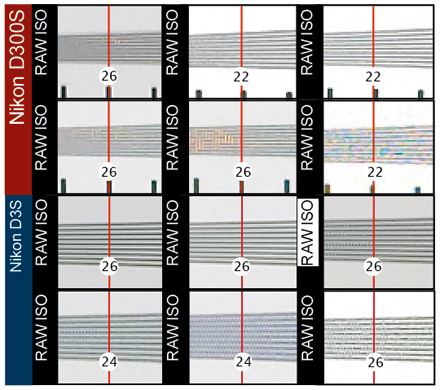
The Nikon D300S and D3S are closely related, and although one has an APS-C-sized sensor and the other has a full-frame device they have a great deal in common.
The D3S demonstrates what is currently possible with a 12.1-million-pixel full-frame sensor; our tests reveal that it controls noise exceptionally well, even at very high-sensitivity settings.
Consequently, Nikon has set the highest native sensitivity setting to ISO 12,800, but this may be expanded a further 3 stops to the equivalent of ISO 102,400. Noise levels are comparatively high at this setting, but it means the camera is able to operate in light levels that previously required specialist infrared kit.
While the D300S is an excellent camera, its smaller sensor has almost the same pixel count (12.3 million) as the full-frame D3S and, as a consequence, noise becomes noticeable lower down the sensitivity range. At ISO 1600, for instance, images from the D300S have about the same amount of noise as those taken at ISO 12,800 on the D3S. Although their pixel count is very similar, the D3S’s low noise levels enables it to record a little more detail than the D300S, but the difference is not dramatic and the D300S is very capable.
Comparing the camera sizes
Traditionally, we expect professional-level and full-frame cameras to be larger and heavier than those with APS-C or smaller-format sensors aimed at enthusiasts.
This is borne out by the differences between the Nikon D300S (147x114x74mm and 825g) and cameras further up the Nikon DSLR line such as the D700 (147x123x77mm and 995g) and D3S (159.5x157x87.5mm and 1,240g).
Similarly, the Sony Alpha 850 is considerably larger (156.3×116.9×81.9mm) and heavier (850g) than the Alpha 550 (137x104x84mm and 599g).
However, there are only a few millimetres difference between the Canon EOS 7D (148.2×110.7×73.5mm) and EOS 5D Mark II (152×113.5x75mm) and, at 820g, the EOS 7D is 10g heavier than its full-frame counterpart.
It is worth bearing in mind that full-frame lenses have to cover a larger imaging circle than their APS-C-format equivalents, so they are generally larger and heavier. Consequently, it may not be the cameras that determine the difference in weight of a camera bag, but the optics used with them.
| Camera | Dimensions | Weight |
| Canon EOS 7D | 148.2×110.7×73.5mm | 820g |
| Canon EOS 5D Mark II | 152×113.5x75mm | 810g |
| Nikon D300S | 147x114x74mm | 825g |
| Nikon D700 | 147x123x77mm | 995g |
| Nikon D3S | 159.5x157x87.5mm | 1,240g |
| Sony Alpha 550 | 137x104x84mm | 599g |
| Sony Alpha 850 | 156.3×116.9×81.9mm | 850g |
APS-C vs Full frame – Conclusion
As this investigation has shown, new developments in sensor technology mean that the APS-C-format EOS 7D is capable of resolving almost as much detail as the full-frame EOS 5D Mark II and the results have a similar level of noise.
However, the D3S and D300S demonstrate the positive impact that larger photosites can have upon the level of noise in image. Meanwhile, the Sony Alpha 850 and Alpha 550 show how increasing the pixel count of a camera allows it to capture more detail.
When Canon eventually replaces the EOS 5D Mark II, it is reasonable to expect the new camera to have technology that is at least on a par with, if not ahead of, that found in the EOS 7D, and the pixel count could go up. This is purely speculation, but it would mean that the full-frame camera could jump ahead of the EOS 7D.
While manufacturers now offer very short focal length lenses to counter the negative aspects of the focal-length magnification factor experienced with APS-C-format cameras, the optics specifically designed for the smaller format don’t tend to have as large a maximum aperture as their full-frame counterparts. This isn’t a problem for photographers concerned with capturing images with extensive depth of field, but those who like to shoot with limited depth of field may struggle to achieve the degree of blur they want.
On the plus side, wildlife and sports photographers are able to frame their subjects more closely with smaller, less costly lenses when they shoot with an APS-C-format camera than when they use a full-frame camera.
Differences in size and weight have in the past been a deciding factor for photographers choosing between a full-frame and an APS-C-format camera, but the EOS 7D and EOS 5D Mark II indicate this may not always be the case.
Given that the EOS 7D and EOS 5D Mark II are both capable of producing images that make good A2 prints, perhaps we have reached the point where photographers can choose between full-frame and APS-C-format cameras on the basis of the type of photography they prefer, rather than because of significant differences in the quality of the images they produce.

